
Introduction
The escalation of heat waves as a severe weather phenomenon has emerged as a pressing concern for disaster management in India, owing to its extensive and detrimental impact on both public health and the environment. Over the past few years, the intensification of heat waves during the summer season has resulted in a significant rise in morbidity and mortality rates across the country. Given the current circumstances, it is imperative to mount effective responses aimed at safeguarding lives and well-being, while also formulating strategies for mitigating and managing the risks posed by heat wave conditions in the future. The prevalence of extreme weather conditions has become increasingly conspicuous, affecting communities worldwide, particularly over the past decade. Consequently, there is an urgent need to comprehend and address the challenges associated with extreme heat events to enhance community resilience.
The frequency of heat waves during summer, along with cold waves in winter and unexpected bouts of extreme rainfall, has seemingly become the new norm, as evidenced by recent occurrences. Climate change is widely acknowledged as a key driver behind the escalation of average temperatures, thereby amplifying the likelihood of severe heat wave events. The adverse effects of extreme heat, including heat stress and heat stroke, pose grave health risks and can have fatal consequences. Despite the heightened media attention on this emerging threat, it serves as a stark reminder of the capricious nature of our environment and the urgent need for proactive measures. Heat waves are often referred to as "silent killers" among the spectrum of natural disasters of hydro-meteorological origin. The escalating temperatures, coupled with the increasing frequency, duration, and intensity of heat spells, present significant challenges to human safety and sustainable development.
The 2010 Indian heat wave serves as a wake-up call, emphasizing the imperative for inter-governmental cooperation, preparedness, and community engagement to mitigate the loss of lives resulting from such extreme events. Notably, 2014 surpassed 2010 as the warmest year on record in India, marking a trend consistent with global temperature records dating back to the 1880s. The fact that the ten warmest years on record have occurred since 1997 underscores the undeniable reality of planetary warming, attributed largely to anthropogenic emissions, which poses profound and long-term risks to human civilization. A pertinent question that arises is, "How hot is too hot?" and whether we possess the capacity to adapt and cope effectively.
The escalating death toll from heat waves, particularly in states such as Odisha, Telangana, and Andhra Pradesh, underscores the pressing need to reassess our preparedness to address such eventualities. From the perspective of hazard mitigation, the rising number of heat wave-related fatalities serves as a stark warning sign, necessitating the development of innovative approaches to mitigate losses during the summer months.
What are heat waves?
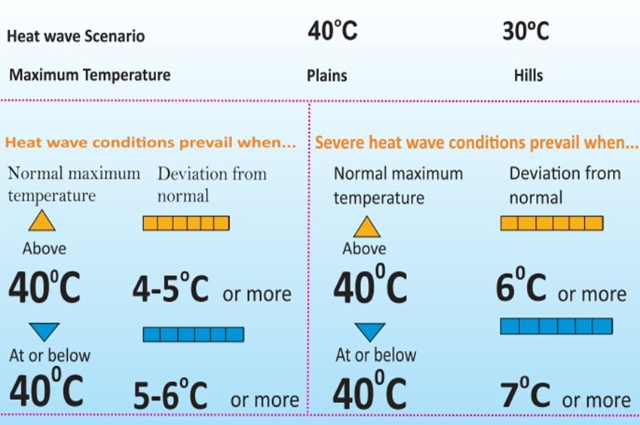
[IMAGE CREDIT: https://nidm.gov.in/]
A heat wave, considered a hazardous disaster scenario, is not merely an increase in temperature but a complex amalgamation of hydro-climatic risks intertwined with social, occupational, and public health hazards. It is characterized by a prolonged period of abnormally high temperatures, surpassing the usual maximum temperatures experienced during the summer season, particularly prevalent in the North-Western regions of India. Typically occurring between March and June, heat waves can occasionally extend into July, subjecting inhabitants of affected areas to physiological stress, and in severe cases, resulting in fatalities. Although there exists no universal definition for a heat wave, it is commonly understood as a sustained period of excessive heat.
The Indian Meteorological Department (IMD) delineates specific criteria for identifying heat waves:
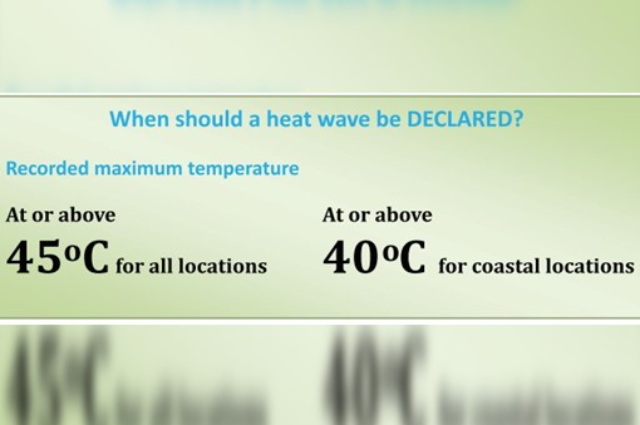
[IMAGE CREDIT: https://nidm.gov.in/]
- For plains, a heat wave is not considered until the maximum temperature of a station reaches at least 40°C, while for hilly regions, it is at least 30°C.
- When the normal maximum temperature of a station is ≤40°C, a departure from the normal by 5°C to 6°C qualifies as a heat wave, and a departure of 7°C or more is classified as a severe heat wave.
- When the normal maximum temperature exceeds 40°C, a departure from the normal by 4°C to 5°C is considered a heat wave, and a departure of 6°C or more is classified as a severe heat wave.
- A heat wave is also declared when the actual maximum temperature remains at 45°C or more, regardless of the normal maximum temperature.
While definitions may vary across regions and countries, heat waves are generally assessed relative to typical weather patterns and seasonal temperatures. The World Meteorological Organization (WMO) defines a heat wave as occurring when the daily maximum temperature exceeds the average maximum temperature by 5°C for more than five consecutive days, with the normal period considered being 1961-1990.
Global trends reveal a significant increase in extreme heat events. 2015 marked the hottest year on record globally, surpassing the previous record set in 2014, and witnessing an increase in the proportion of the earth's surface experiencing extremely hot summers. Various regions worldwide, including Australia, Argentina, China, Europe, Mexico, Japan, South Korea, and the USA, have witnessed record-breaking heat events.
In India, the impact of heat waves has been profound. In 2015, a heat wave claimed over 2,300 lives in India, ranking it as the fifth deadliest globally in terms of the number of fatalities. The states most affected included Andhra Pradesh, Telangana, Punjab, Odisha, and Bihar. In 2016, global temperatures continued to soar, with India experiencing severe heat wave conditions during April, resulting in numerous heat-related deaths.
Global Heat Wave Conditions in April 2024
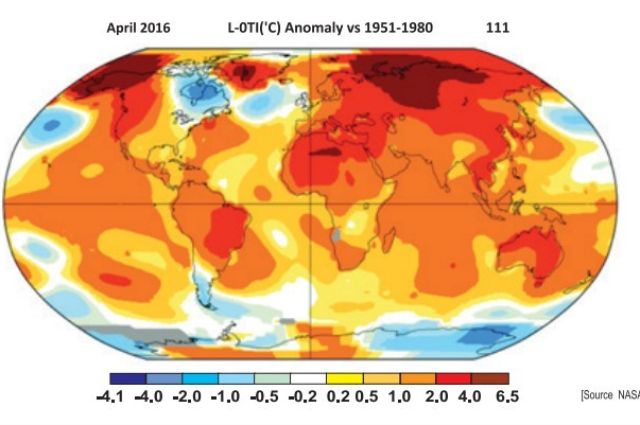
[IMAGE CREDIT: https://www.nasa.gov/]
April 2024 witnessed unprecedented global heat wave conditions, with the combined average temperature over land and ocean surfaces soaring to 1.10°C (1.98°F) above the 20th-century average of 13.7°C (56.7°F). This marked the highest temperature departure for April since records began in 1880, surpassing the previous record set in 2010 by 0.28°C (0.50°F). Notably, April 2024 ranked as the fourth-highest monthly temperature departure on record.
In India, the absence of thunderstorms and rainfall in March-April 2023 and 2024 exacerbated the prevailing high temperatures, providing little respite to residents. Numerous regions experienced temperatures exceeding 45°C, with many areas consistently recording temperatures above normal. Particularly affected were West Bengal, Odisha, Bihar, Jharkhand, Uttar Pradesh, Maharashtra, Telangana, and Andhra Pradesh. Between mid-March and mid-April 2024, maximum temperatures, excluding northeastern states and Jammu and Kashmir, surpassed normal levels by 2-4°C, with the most significant impact observed in north-central and eastern India.
Ten Highest Mortality Heat Events Across the Globe (2001-2010)
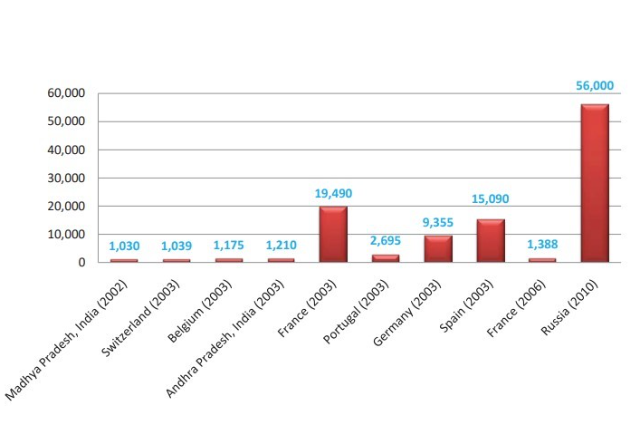
[IMAGE CREDIT: https://nidm.gov.in/]
During the period of 2001-2010, extreme weather and climate conditions resulted in over
370,000 fatalities, marking a 20% increase compared to the preceding decade (1991-2000). Of these deaths, heat waves alone accounted for approximately 136,000 fatalities, a stark rise from less than 6,000 recorded in 1991-2000. This increase, exceeding 2,000%, can largely be attributed to devastating heat waves in Europe in 2003 and Russia in 2010.
The prevalence of extreme heat events was evident globally, with 44% of countries reporting their highest temperatures during the years 2001-2010, a notable increase from the 24% recorded in 1991-2000. The surge in heat-related fatalities and record-breaking temperatures can be attributed to a combination of factors, including seasonal climatology, prevailing atmospheric circulation patterns (such as wind and cloudiness), and long-term trends associated with global warming.
These ten years witnessed some of the deadliest heat events in recent history, underscoring the urgent need for comprehensive measures to mitigate the impacts of extreme heat and adapt to changing climatic conditions on a global scale.
Heat Wave Risks and Vulnerability Assessment
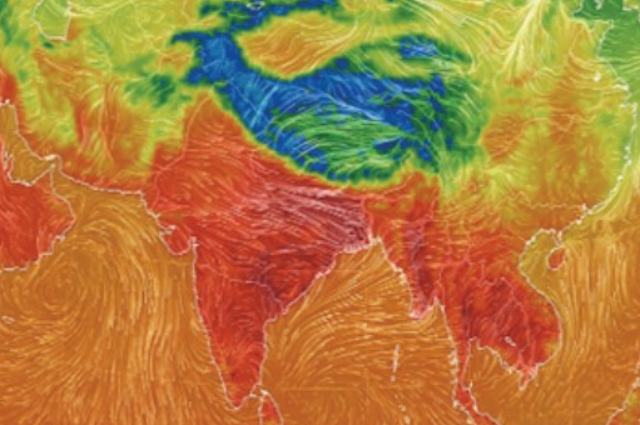
[IMAGE CREDIT: Earth Nullschool]
The discomfort experienced during heat waves is influenced by a multitude of factors, including meteorological conditions such as air temperature, humidity, wind, and direct sunlight, as well as cultural and physiological factors such as clothing, occupation, accommodation, health status, fitness level, age, and acclimatization ability. Consequently, conducting a comprehensive vulnerability assessment is essential to effectively address the risks associated with heat waves.
Key objectives of vulnerability assessment include:
- Collecting reliable data on morbidity rates to accurately gauge the impact of heat waves on public health.
- Understanding cultural practices and behaviors to tailor appropriate strategies and interventions.
- Mapping community-level capacities and resources to facilitate targeted interventions and response measures.
- Assessing the perception and utilization of government-initiated actions among the populace.
- Identifying the most vulnerable population groups and developing targeted action plans to safeguard their well-being.
- Implementing mitigation and preparedness measures specifically tailored to address the needs of vulnerable populations.
- Redesigning livelihoods or working environments for vulnerable groups during the summer months to minimize heat-related risks.
- Incorporating "heat-friendly" city planning methods and measures into urban development strategies to enhance resilience to extreme heat events.
By conducting a thorough vulnerability assessment and implementing targeted interventions, communities can better prepare for and mitigate the adverse effects of heat waves, thereby safeguarding public health and well-being during periods of extreme heat.
Impact of Heat Waves as a Disaster
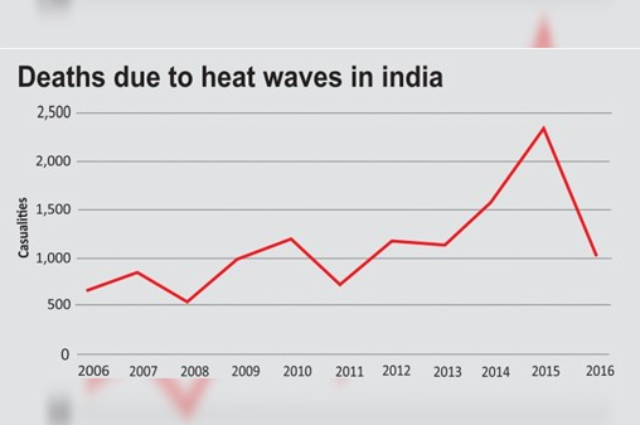
[IMAGE CREDIT: India NDMA]
Heat waves predominantly occur over interior plain areas, where dry and warmer air is transported, leading to maximum insulation during the summer season. Coastal regions such as the Bay Islands, Lakshadweep, Tamil Nadu, Kerala, Coastal and South Interior Karnataka are less affected by heat waves due to the presence of maritime air. However, the impacts of heat waves are increasing and taking a significant toll on human lives.
In addition to cities and villages, specific industrial operations such as mining, thermal power, furnaces, and refineries emit and absorb considerable heat, posing risks to the workforce in these sectors. With many workplace settings in developing countries being influenced by outdoor temperatures, both indoor and outdoor workers are at risk of experiencing increased heat stress due to climate change.
Heat waves also profoundly affect the natural habitat, contributing to increased forest fires and significant damage to ecosystems and wildlife. Recent examples include the Fort McMurray wildfire in Alberta, Canada, and forest fires in Uttarakhand, India, which necessitated large-scale evacuations. In India, approximately 6.17% of forests are prone to severe fire damage, and with heightened heat stress, this vulnerability is expected to increase.
Moreover, heat waves exacerbate the vulnerability of water resources, leading to increased evaporation rates, which, in turn, impact humans, natural habitats, and economic activities such as agriculture and livestock rearing.
The mortality rate rises sharply within a day or two after extreme temperatures, highlighting the critical need for swift and effective action. However, vulnerable populations may not always recognize the increased risk, making these events even more dangerous. Nevertheless, physiological and behavioral adaptations, along with changes in public health preparedness, can help reduce heat wave-related fatalities.
Urban areas experience more severe heat health impacts due to the Urban Heat Island (UHI) effect, where residents are exposed to higher and nocturnally sustained temperatures compared to surrounding areas. Factors such as heat-absorbing surfaces, limited tree cover, pollution, climate change, and urban design contribute to the intensity of the UHI effect. Consequently, higher urban temperatures result in increased energy use, air pollution, negative effects on human health and comfort, and warmer stormwater runoff, impacting water quality.
Overall, heat waves are reported as silent killers, underscoring the urgent need for proactive measures to mitigate their impacts on human health, ecosystems, and urban environments. Early warning systems, adaptive strategies, and community engagement are crucial in reducing the adverse effects of heat waves and enhancing resilience to extreme heat events.
Why there is an increasing trend in heat waves in India?

[IMAGE CREDIT: Indian Meteorological Department]
The increasing trend in heat waves in India can be attributed to a combination of natural climate variability and anthropogenic climate change.
Firstly, natural climate variability plays a significant role. India's geographical location and topography make it susceptible to various weather systems, including the Indian Ocean Dipole (IOD), El Niño-Southern Oscillation (ENSO), and the monsoon. Fluctuations in these climate phenomena can lead to alterations in temperature patterns, resulting in periods of extreme heat. For instance, when the IOD is in its positive phase, it can contribute to drier conditions and warmer temperatures over the Indian subcontinent, exacerbating heat wave events.
Secondly, anthropogenic climate change has exacerbated the frequency, intensity, and duration of heat waves in India. The increase in greenhouse gas emissions, primarily carbon dioxide from the burning of fossil fuels, has led to a rise in global temperatures. This warming trend amplifies the likelihood of extreme heat events occurring more frequently and with greater severity. Studies have shown a clear link between anthropogenic climate change and the increased incidence of heat waves in various regions, including India.
Additionally, urbanization and land-use changes contribute to the urban heat island (UHI) effect, further exacerbating heat wave conditions in cities. The proliferation of concrete structures, reduced green spaces, and increased heat-absorbing surfaces elevate temperatures in urban areas, making them more susceptible to heat waves. Rapid urbanization also leads to changes in local climate dynamics, such as altered wind patterns and reduced moisture levels, which can exacerbate heat stress.
Furthermore, socio-economic factors such as population growth, inadequate infrastructure, and socio-economic disparities exacerbate the impacts of heat waves. Vulnerable populations, including the elderly, children, and outdoor workers, are disproportionately affected due to factors such as limited access to cooling facilities, inadequate housing, and underlying health conditions.
In conclusion, the increasing trend in heat waves in India is driven by a combination of natural climate variability and anthropogenic climate change. Addressing this issue requires comprehensive mitigation and adaptation strategies, including reducing greenhouse gas emissions, enhancing urban planning and infrastructure, implementing early warning systems, and prioritizing the protection of vulnerable populations. Failure to take proactive measures to mitigate the impacts of heat waves could have devastating consequences for public health, agriculture, and the environment in India.
Health Impacts of Heat Waves

[IMAGE CREDIT: https://nidm.gov.in/]
Excessive exposure to heat waves can result in a spectrum of medical disorders, ranging from mild discomfort to life-threatening conditions. Four main disorders associated with heat waves are heat rash, heat syncope, heat cramps, heat exhaustion, and heat stroke, each presenting distinct signs and symptoms. Heat rash manifests as pinkish skin, burning sensations, and pain. Heat syncope is characterized by giddiness, vertigo, headache, and sudden onset drowsiness or unconsciousness. Heat cramps involve edema and syncope, often accompanied by fever below 39°C (102°F). Heat exhaustion presents with fatigue, weakness, dizziness, headache, nausea, vomiting, muscle cramps, and excessive sweating. Heat stroke, the most severe condition, is indicated by body temperatures of 40°C (104°F) or higher, accompanied by delirium, seizures, or coma, and can be fatal.
Moreover, heat waves contribute to the rise in cases of acute gastroenteritis and food poisoning due to the spoilage of food and reduced shelf life in high temperatures. Alcohol fermentation can also lead to poisoning. Additionally, extreme temperature increases are associated with a surge in cases of anxiety, palpitations, nervousness, and behavioral changes.
The occupational profile of heat wave victims predominantly includes agricultural laborers, coastal community dwellers, and individuals from below the poverty line (BPL) category, with mostly outdoor occupations. Vulnerability to extreme heat events depends on the level of exposure, individual sensitivity, and capacity to adapt. Particularly vulnerable populations include the elderly, infants, the mentally ill, and those with pre-existing health conditions such as heart, kidney, lung, or liver diseases.
India has witnessed a significant increase in heat-related deaths over the past two decades, with recurring heat waves occurring more frequently and with greater intensity each year. Since 1992, heat waves have claimed over 22,562 lives in India, with the worst casualties recorded in 2015, totaling 2,422 deaths. The India Meteorological Department reports a concerning trend of heat waves occurring with increasing frequency and intensity, underscoring the urgent need for both mitigation and adaptation strategies to address the impact of extreme heat. Embedding temperature norms into planning and monitoring systems is imperative to safeguard public health and mitigate the adverse effects of heat waves effectively.
Heat Wave Safety Measures
- Avoid exposure to the hot sun, especially between 12:00 PM and 3:00 PM, if possible.
- Stay hydrated by drinking water at frequent intervals, even if you're not thirsty. Carry water with you when traveling.
- Wear light-colored, loose-fitting cotton clothes. Use protective gear such as goggles, an umbrella, a cap, or a cloth to cover your head, shoes, and sandals when going out in the sun.
- Avoid engaging in strenuous activities outdoors during peak heat hours.
- If you must work outside, use a damp cloth or umbrella to shield your head from direct sunlight.
- Consume light meals and fruits with high water content, such as melons, cucumber, and citrus fruits. Avoid protein-rich foods like meat and nuts, which can increase metabolic heat. Refrain from eating outside or consuming stale food.
- Opt for homemade and traditional healthy beverages like lemon water, buttermilk, and juices to stay hydrated.
- Never leave children or pets unattended in parked vehicles. Ensure they have access to shade and water.
- Keep animals in shaded areas and provide them with ample water.
- Maintain a cool home environment by using curtains, shutters, or sunshades. Open windows at night to promote ventilation.
- Stay informed about local weather forecasts and anticipate temperature changes.
- Seek immediate medical attention if you experience illness or fainting due to heat.
What to Do in Case of Heat Stroke:
- Move the person indoors or to a cool, shady area. Have them lie down with their feet slightly elevated.
- Use a damp cloth or spray cold water on their skin to help lower their body temperature. 3. Provide the person with oral rehydration solutions (ORS), lemon water, salt-sugar solutions, or juice to replenish lost fluids.
- Do not give anything to eat or drink to an unconscious person.
- If symptoms persist or worsen after one hour, seek medical assistance at the nearest health center.
Heat Action Planning Framework
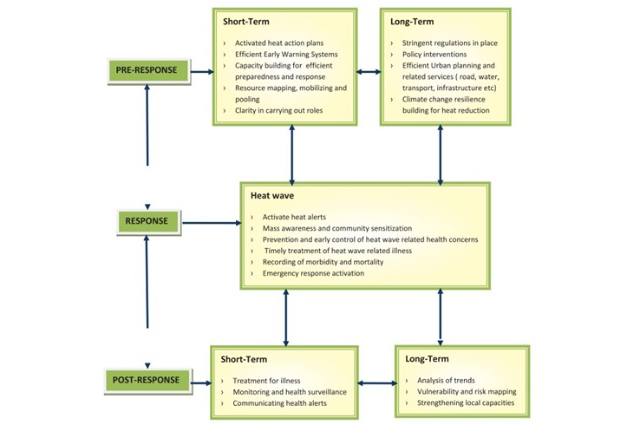
Developing effective heat wave risk mitigation and response plans, commonly known as Heat Action Plans, requires a comprehensive framework encompassing various stages and strategies. National and international examples offer valuable insights for designing and implementing such plans.
The Ahmedabad Heat Action Plan (AHAP), launched in 2013, serves as a pioneering example in India. Developed by the Ahmedabad Municipal Corporation (AMC) in collaboration with domestic and international experts, AHAP focuses on four key strategies:
- Building public awareness: AHAP emphasizes mass outreach programs in local languages to raise awareness about the risks associated with heat waves.
- Implementing response systems: The plan aims to prevent heat-related deaths and illnesses through timely response mechanisms at the onset of heat waves.
- Establishing an Early Warning System (EWS): AHAP includes the development of an EWS to alert citizens about predicted extreme temperatures and facilitate proactive measures.
- Capacity building: AHAP emphasizes capacity building among city officials and healthcare professionals to recognize and respond to heat-related illnesses effectively.
AHAP's success has inspired similar initiatives in other regions, such as Maharashtra and Odisha. These efforts underscore the importance of customized heat alert plans tailored to the specific needs of states and regions.
In addition to local initiatives, national-level strategies are crucial for addressing the escalating impacts of heat waves. The year 2015 marked a significant milestone in recognizing the severity of heat wave impacts in India, particularly in states like Andhra Pradesh, Telangana, Punjab, Odisha, and Bihar. The global acknowledgment of climate change's role in intensifying extreme heat events further emphasizes the need for proactive measures.
The success stories from Gujarat have paved the way for collaborative efforts in other regions. For instance, the Nagpur Regional Heat Action Plan in Maharashtra and similar initiatives in Odisha demonstrate the importance of regional coordination and leadership.
It is essential to recognize that there is no one-size-fits-all approach to heat wave management. Strong local leadership, coupled with national support and collaboration, is key to implementing effective heat action plans. Furthermore, embedding adaptive measures into everyday life and infrastructure planning is crucial for building resilience to rising temperatures and extreme heat events. By learning from past experiences and adopting a proactive approach, India can effectively mitigate and adapt to the challenges posed by changing climatic conditions and extreme heat.
Key Recommendations and Way Forward for Heat Wave Mitigation

[IMAGE CREDIT: UHW- Mitigation and Adaptation strategy]
- Tap into Indigenous Knowledge: Document and research traditional methods of protection against heat waves and strokes, and raise awareness about these practices among communities.
- Reduce Food and Water Wastage: Implement measures to minimize food and water wastage in hotels and private events, especially during periods of high heat.
- Identify Shelter Locations: Identify and construct shelters and shades in urban areas, particularly targeting vulnerable groups such as the urban poor and slum dwellers. Increase insulation and building standards to enhance heat tolerance in new infrastructure and retrofit existing buildings.
- Public Awareness and Outreach: Launch comprehensive public awareness campaigns to educate people about the risks of heat waves and preventive measures. Utilize various media outlets and modern communication technologies such as SMS, email, radio, and mobile applications to disseminate information, with a focus on reaching vulnerable populations.
- Lifestyle Adaptation: Recognize the impact of lifestyle choices on health in response to changing weather patterns. Encourage adaptive behaviors and practices to minimize heat-related risks.
- Utilize Scientific Capabilities: Link the impacts of heat waves with other hazards and disseminate information on protective measures to the general public. Utilize scientific research to understand the interconnectedness of various environmental factors and develop effective mitigation strategies.
- Preserve Natural Shelters: Address the destruction of natural shelters for vested interests, which disrupts ecosystem services. Conduct research in this area and develop policy papers to ensure the preservation of natural habitats.
By implementing these recommendations, communities can better prepare for and mitigate the impacts of heat waves, ultimately reducing the risk of heat-related illnesses and fatalities.
. . .
References:
- Indian Heat Wave scenario - Wikipedia. Retrieved from:[http://en.wikipedia.org/wiki/2015_Indian_heat_wave](http://en.wikipedia.org/wiki/2015_I ndian_heat_wave)
- Ahmedabad - Gujarat Municipal Corporation’s Heat Action Plan.
- Telangana – Andhra Pradesh State Heat Action Plan.
- Odisha State Heat Action Plan.
- Times of India news: Retrieved from [http://timesofindia.indiatimes.com](http://timesofindia.indiatimes.com)
- Heat Health Action Plans: World Health Organization, 2008.
- Heat waves and Health: Guidance on Warning System. World Meteorological Organization and World Health Organization, 2015.
- Hem H. Dholakia, Vimal Mishra and Amit Garg. Predicted Increases in Heat-Related Mortality under Climate Change in Urban India. Indian Institute of Management, Ahmedabad, June 2015.
- Every year could bring a heat wave if climate change continues. (2016). Reuters. Retrieved from [http://www.reuters.com](http://www.reuters.com)
- Heat wave. (2016). Met Office. Retrieved from [http://www.metoffice.gov.uk](http://www.metoffice.gov.uk)
- Heat wave (2016). National Disaster Management Authority. Retrieved from [http://www.ndma.gov.in](http://www.ndma.gov.in)
- Global Analysis - April 2016 | State of the Climate | National Centers for Environmental Information (NCEI). (2016). Retrieved from [https://www.ncdc.noaa.gov/sotc/global/201604](https://www.ncdc.noaa.gov/sotc/global/201 604)
- Urban Heat Island Effect and Its Mitigation Strategies. TARU, 2014-2015.
- Challenges 2015: Concept Paper - Retrofitting Precincts for Heat Wave Resilience: Challenges and Barriers in Australian Context by Gertrud Hatvani-Kovacs and John Boland, Published: January 2015.
